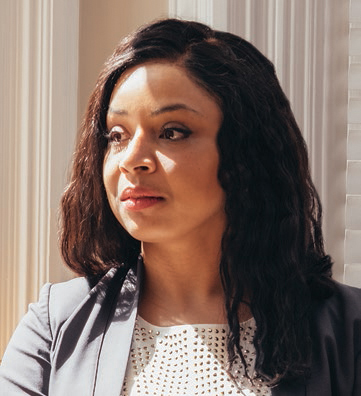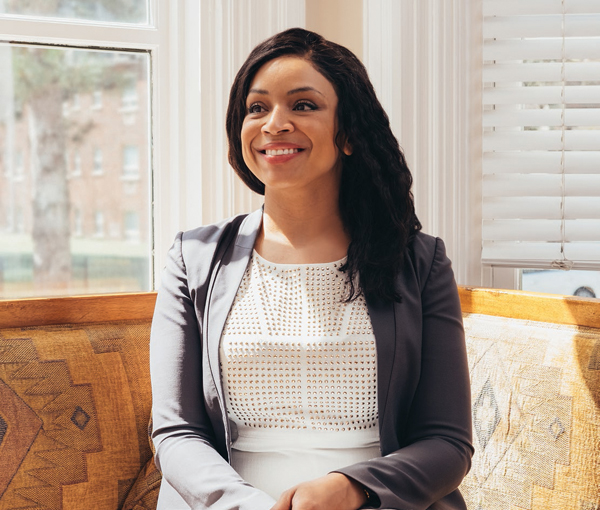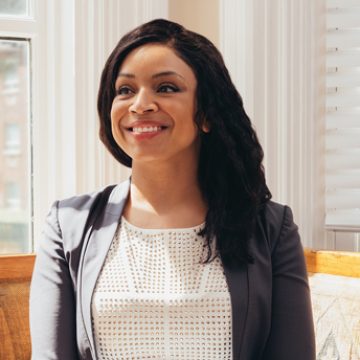When Annamaria Enenajor entered law school, at McGill University, she encountered a pretty common problem: after a lifetime of straight-A report cards, her grades started to drop. So she booked a session with an academic counsellor. “But instead of offering advice, the counsellor said, ‘You know, law school is not for everyone. Maybe this isn’t your thing,’” recalls Enenajor. “I was furious, but defiant. I left thinking, That woman is wrong.”
Ten years have passed since that moment. At 34, Enenajor has made partner at the law firm of Clayton Ruby and Brian Shiller, two of the country’s top litigators, and maintains a busy defence practice. And she has become a go-to media pundit on the criminal-justice system. You may have heard her on CBC radio (discussing the jury-selection process), watched her on TVO (tearing into the racist underpinnings of our drug laws) or read her on Twitter (where 1,800 users follow her insightful feed). There is no debate: the counsellor was wrong.
To friends and colleagues, that success seems effortless. “I have no clue how she developed this across-the-board knowledge of the criminal-justice system,” says Shiller. Her friend, Lisa Kerr, a law professor at Queen’s University, is certain that Enenajor never breaks a sweat. “Why is she so young and such a baller? Because she is uniquely energetic and confident.”

“It has taken a lot of hard work to get where I am,” says Annamaria Enenajor.
This is true. When I meet with Enenajor for lunch, she is bright and animated. But that personality, I quickly learn, can mislead. “People may think that all aspects of the practice of law come easily to me,” she says. “But I find some of it difficult. It has taken a lot of hard work to get where I am.”
Her struggle began in law school, but it went beyond grades. Enenajor suffers from anxiety, a condition that pollutes her mind with negative thoughts. And the symptoms were most acute in law school. Before writing an exam, she would think, You’re not good enough. You’re a failure. “I started to meditate and see a therapist,” she says. “That really helped to counteract the limiting beliefs I had about myself.” As her mental health improved, so, too, did her grades.
In that first year, already thinking about her career, she attended a raft of open houses on Bay Street. “But the firms felt stodgy, homogenous and lacking in vision,” she recalls. “There was nothing that attracted me.” So the next year, when applying for second-year summer jobs, she looked to New York. The global mega-firm Ropes & Gray caught her eye. “The firm had a massive pro bono program and a clear vision of how it wants to make the world a better place.” Enenajor secured an interview and, shortly after, landed the job.
After law school, she clerked at the Supreme Court of Canada under Richard Wagner (who became Chief Justice this past December). But at the end of the clerkship, she couldn’t decide which practice area to pursue. So she returned to Ropes & Gray, as an associate in the litigation group, where she could receive the broadest training.
On arrival, she took an active role in the firm’s class-action lawsuit against the Rikers Island prison over its excessive violence toward inmates. The case was revelatory. “I saw the overrepresentation of racialized communities and those with mental illness in the prison population,” she says. “I knew then that I wanted to practise criminal law.”
But she wanted to return to Canada. (“I knew in my heart that I’d never be American,” she explains.) Through a colleague, she connected with Nader Hasan and Gerald Chan, who practised defence law with Clayton Ruby (they are now partners at Stockwoods LLP). That led to a lunch interview with all three of them: Hasan, Chan and Ruby. They hit it off and, in April 2015, she joined the firm as an associate.
The transition to criminal law, however, was not easy. “Within a week of starting,” says Enenajor, “I was in court.” To get up to speed, she worked all the time. And she still does. At lunch, I ask Enenajor to break down her work-to-life ratio. “I think it’s 80–20,” she replies, then corrects herself. “Okay, it’s probably 85–15.”
That sacrifice has paid off. Last fall, she made partner. And, over the past three years, she has handled everything from charges of mischief to aggravated assault. Kerr has taken note of her friend’s work ethic. “Like most brilliant, ambitious lawyers, she works very hard,” she says. “Sometimes, I worry about that.”
When I mention this to Enenajor, she pushes back. “When friends tell me I work too hard, they’re imposing their standards on me. I would rather do work than almost anything else. This is my choice.”

Timeline of a criminal lawyer
1990: At six, Enenajor moves with her family from Slovakia to Edmonton, where her mother studies Slavic linguistics.
1992: Her mother’s student visa expires and the family moves to Nigeria, the home country of her father. One year later, they immigrate to Canada and settle in Toronto.
2002: Enenajor starts her undergrad at the University of Toronto, studying international relations and Christianity and culture.
2006: She enrolls in the University of Oxford’s Refugee and Forced Migration master’s program.
2008: As a 1L at McGill University, she finds “the learning curve to be incredibly steep. I wasn’t prepared for that.”
2012: On graduation, she clerks at the Supreme Court of Canada. “It was busy, but I had so much fun.”
2013: Enenajor moves to New York to join Ropes & Gray.
2015: After catching the criminal-law bug, she moves back to Toronto and practises under Clayton Ruby and Brian Shiller.
2017: Enenajor makes partner and the firm is rebranded as Ruby Shiller & Enenajor Barristers. One of her overarching priorities is to serve the poor. “I take legal-aid cases and I tailor my billable rate to what clients can afford. But I have turned people away who can’t pay. That weighs terribly on my mind.”
This story is from our Summer 2018 Issue.
Photography by Reynard Li


